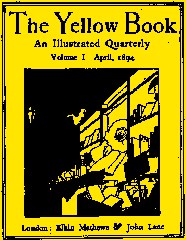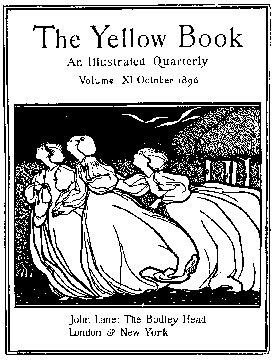According to Henry Harland, the expatriate American writer who became the magazine's literary editior, The Yellow Book was conceived on New Year's Day, 1894:

In one of the densest and soupiest and yellowest of all London's infernalest fogs, Aubrey Beardsley and I sat together the whole afternoon... We declared to each other that we thought it quite a pity and a shame that London publishers should feel themselves longer under any obligation to refuse any of our good manuscripts...And then and there we decided to have a magazine of our own...and the next day we had an appointment with Mr. John Lane.
In truth the idea had originated months before, among a cosmpopolitan group of writers and artists who congregated at the French resort of Dieppe, a group which included not only Beardsley and Harland but also the painters Walter Sickert and Charles Conder, the critic-artist D. S. MacColl, and the publisher John Lane, whose firm, the Bodley Head, specialized in poets and belles lettres. What they had in mind was a new type of journal which would attract attention by its format, by its contents, and -- unusual for the time -- by the complete separation of its literary side from its artistic side. Though the magazine was to typify "the new movement" in art and literature in many minds, the list of contributors was not extremely radical: Edmund Gosse, Walter Crane, Sir Frederick Leighton, and Henry James among others. Notably absent from its pages was Oscar Wilde, who was expressly barred though he was published by Mathews and Lane at the Bodley Head. According to Stanley Weintraub, "The color of The Yellow Book was an appropriate reflection of the 'Yellow Nineties," a decade in which Victorianism was giving way among the fashionable to Regency attitudes and French influences; For yellow was not only the decor of the notorious and dandified pre-Victorian Regency, but also of the allegedly wicked and decadent French novel" (Weintraub, 99).
 The first volume, published by the Bodley Head on 16 April 1894, was highly anticipated, and went through three printings to satisfy demand. The critics,
however, vilified both the text and the artwork, especially Beardsley's. More biting than the straightforward criticism, though, were the parodies of Beardsley's work and the magazine in Punch, a British political/social comic weekly.
The first volume, published by the Bodley Head on 16 April 1894, was highly anticipated, and went through three printings to satisfy demand. The critics,
however, vilified both the text and the artwork, especially Beardsley's. More biting than the straightforward criticism, though, were the parodies of Beardsley's work and the magazine in Punch, a British political/social comic weekly.
To put the critics in their place, Beardsley published in Volume III two drawings by him in differing styles under the names Phillip Brouqhton and Albert Foschter. The Saturday Review exemplified the general reaction by finding Beardsley's work "as freakish as ever," but found Broughton's "a drawing of merit," and Foschter's "a clever study." Once he had fooled enough critics, Beardsley admitted the hoax.
The Yellow Book was successful, despite the critics, until Oscar Wilde's arrest in April 1895. When Wilde (who openly despised the publication) was arrested, he was seen clutching a book with a yellow cover. It was assumed to be The Yellow Book, or at least was reported as such in the newspapers. Contributors such as William Watson demanded that Beardsley be fired as art editor because of his association with Wilde (he had illustrated Wilde's Salome the year before) and the Bodley Head's premises were set upon by a mob who broke every window. Under pressure, Lane sacked Beardsley and removed all traces of the artist -- but the back cover and the spine, which were overlooked -- from Volume V, then in the final stages of production. Wilde was actually carrying a French novel with a yellow cover when he was arrested; but no doubt he was satisfied with the difficulties he caused to the magazine that denied him. The The Yellow Book continued publication until 1897, its pages open to a wide vareity of writers and artists, particularly women and relative newcomers such as Arnold Bennett, Charlotte Mew, Maurice Baring, who would make their reputations in the coming decades.
Related Material
- A list of images published in the The Yellow Book or associated with it
- Material on Harvard University Centenary Exhibition
Last modified: 16 October 2003
